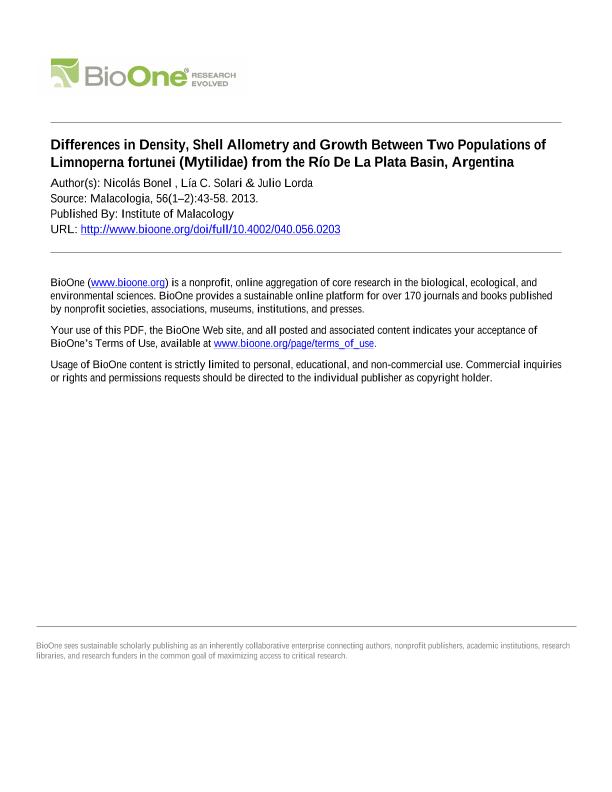Mostrar el registro sencillo del ítem
dc.contributor.author
Bonel, Nicolás

dc.contributor.author
Solari, Lía Cristina

dc.contributor.author
Lorda, Julio
dc.date.available
2017-07-31T19:09:07Z
dc.date.issued
2013-12
dc.identifier.citation
Bonel, Nicolás; Solari, Lía Cristina; Lorda, Julio; Differences in density, shell allometry, and growth between two populations of Limnoperna fortunei (Mytilidae) from the Río de La Plata basin, Argentina; Institute of Malacology; Malacologia; 56; 1-2; 12-2013; 43-58
dc.identifier.issn
0076-2997
dc.identifier.uri
http://hdl.handle.net/11336/21634
dc.description.abstract
The invasive freshwater mussel, the mytilid Limnoperna fortunei (Dunker, 1857), has a great capacity for colonizing a wide range of aquatic environments because of its dispersal ability, high fecundity and wide range of physiological tolerances. Most of the biological and ecological studies of L. fortunei, having been restricted to specific locations, lack comparative analyses among different habitats. In this investigation, we examined the differences in larval density, density in settlement plates, shell allometry, and growth between two populations from the Rio de la Plata basin, Argentina. One of the populations inhabited a heavily polluted area, whereas the other a moderately polluted area. We predicted that the density and growth of the golden mussel would be lower in the heavily polluted environment, expecting therefore to find variations in shell allometry as a consequence of differences in density and environmental conditions between the sites investigated. We accordingly found that the larval density, the density of settled individuals, and the growth were lower in the more polluted environment. We also observed allometric differences because the individuals from the moderately polluted area with higher population densities were more elongated (i.e., with a higher shell length-to-width ratio). The golden mussel tolerates a wide range of environmental conditions and can survive in many polluted water bodies where other invasive species cannot. The findings presented here support the idea that L. fortunei can inhabit heavily polluted environments, but at the expense of a significant decrease in its biologic potential.
dc.format
application/pdf
dc.language.iso
eng
dc.publisher
Institute of Malacology

dc.rights
info:eu-repo/semantics/openAccess
dc.rights.uri
https://creativecommons.org/licenses/by-nc-sa/2.5/ar/
dc.subject
Invasive Species
dc.subject
Freshwater Mussel
dc.subject
Population Dynamics
dc.subject
Growth Rate
dc.subject
Water Pollution
dc.subject.classification
Ecología

dc.subject.classification
Ciencias Biológicas

dc.subject.classification
CIENCIAS NATURALES Y EXACTAS

dc.title
Differences in density, shell allometry, and growth between two populations of Limnoperna fortunei (Mytilidae) from the Río de La Plata basin, Argentina
dc.type
info:eu-repo/semantics/article
dc.type
info:ar-repo/semantics/artículo
dc.type
info:eu-repo/semantics/publishedVersion
dc.date.updated
2017-07-28T17:54:07Z
dc.journal.volume
56
dc.journal.number
1-2
dc.journal.pagination
43-58
dc.journal.pais
Estados Unidos

dc.journal.ciudad
Filadelfia
dc.description.fil
Fil: Bonel, Nicolás. Universidad Nacional del Sur. Departamento de Biología, Bioquímica y Farmacia. Laboratorio de Zoología de Invertebrados I; Argentina. Consejo Nacional de Investigaciones Científicas y Técnicas; Argentina
dc.description.fil
Fil: Solari, Lía Cristina. Consejo Nacional de Investigaciones Científicas y Técnicas. Centro Científico Tecnológico Conicet - La Plata. Instituto de Limnología "Dr. Raúl A. Ringuelet". Universidad Nacional de La Plata. Facultad de Ciencias Naturales y Museo. Instituto de Limnología; Argentina
dc.description.fil
Fil: Lorda, Julio. University of California at Irvine; Estados Unidos
dc.journal.title
Malacologia

dc.relation.alternativeid
info:eu-repo/semantics/altIdentifier/doi/http://dx.doi.org/10.4002/040.056.0203
dc.relation.alternativeid
info:eu-repo/semantics/altIdentifier/url/http://www.bioone.org/doi/full/10.4002/040.056.0203
Archivos asociados
